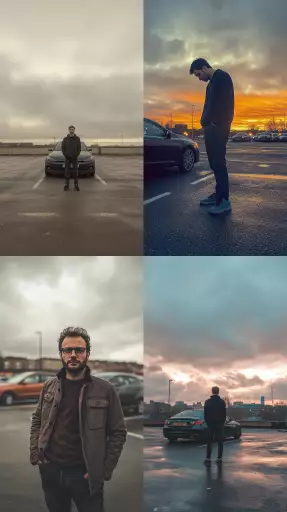Explore the Best AI Image Gallery

From Pixels to Prose: How Wearable Tech is Transforming the Creative Process
The realm of creativity has always been defined by pushing boundaries, experimenting with new tools, and embracing innovation. Today, wearable technology stands as a transformative force, reshaping how we conceive, create, and experience art, design, and storytelling. From augmented reality spectacles that overlay digital elements onto the physical world to haptic gloves that translate touch into tangible sensations, wearables are blurring the lines between the virtual and real, empowering creators with unprecedented levels of expression and interaction.
Innovative Applications in the Creative Sphere
The impact of wearable tech on the creative industry is multifaceted, spanning a wide range of applications:
- Interactive Art Installations: Wearable sensors can be integrated into installations, allowing viewers to influence the artwork through their movements or interactions. This fosters an immersive and participatory experience, blurring the boundaries between artist, artwork, and audience.
- Fashion Design Revolution: Wearables are revolutionizing fashion design by enabling interactive garments that change color, texture, or shape based on the wearers environment or emotions. Smart fabrics can adapt to temperature, light, or even sound, creating dynamic and responsive clothing experiences.
- Augmented Reality Storytelling: AR glasses can enhance narratives by overlaying digital elements onto real-world environments. Imagine walking through a historical site and seeing holographic projections of past events unfold before your eyes, bringing history to life in an immersive way.
- Music Composition and Performance: Wearable sensors can capture a musicians movements, emotions, or even brainwaves, translating them into musical notes or sound effects. This opens up new avenues for creative expression, blurring the lines between performer and instrument.
- Collaborative Design Environments: VR headsets and haptic gloves allow designers to collaborate remotely in shared virtual spaces. This fosters real-time interaction, enabling teams to brainstorm, sketch, and refine designs together seamlessly, regardless of their physical location.
Ethical Considerations Shaping the Future
As wearable tech becomes more integrated into creative processes, its crucial to address the ethical implications that arise:
- Data Privacy and Security: Wearables collect vast amounts of personal data, including biometric information, location data, and even emotional responses. Ensuring the responsible handling and protection of this sensitive data is paramount.
- Accessibility and Inclusivity: Creative tools powered by wearables should be accessible to individuals with diverse abilities. Designing for inclusivity ensures that everyone can participate in and benefit from these advancements.
- Algorithmic Bias: AI algorithms used in creative applications may inherit biases present in the training data, potentially leading to unfair or discriminatory outcomes. Mitigating algorithmic bias is crucial for promoting fairness and equity in the creative process.
Future Trends: A Glimpse into Tomorrows Creative Landscape
The evolution of wearable tech is constantly pushing boundaries, paving the way for exciting future trends:
- Brain-Computer Interfaces (BCIs): BCIs will enable direct communication between our brains and creative tools, allowing us to control virtual environments, generate music, or even paint with our thoughts.
- Personalized Creative Experiences: Wearables will tailor creative experiences to individual preferences, learning our styles, tastes, and inspirations to provide customized suggestions and guidance.
- Seamless Blending of Reality and Virtuality: Advancements in AR and VR will create increasingly immersive and interactive creative environments, blurring the lines between the physical and digital worlds.
Wearable technology is not simply a technological advancement; it represents a profound shift in how we understand and engage with creativity. As these innovations continue to evolve, they hold the potential to empower individuals, foster collaboration, and unlock new frontiers of artistic expression, reshaping the creative landscape for generations to come.
![**Representation: A teenager smiling while thinking about a friendly dog, a comic-style thought bubble with a friendly dog inside. Graphic style: Line drawing, cartoon style, influenced by Franco-Belgian comics, thick black lines, simplified design, vector, black and white only, in the style of Keith Haring or the French comic strip "Alinéa". [IMPORTANT]: A single continuous line extending from one side of the image to the other, minimalist, strong outlines, line drawing, without lifting the hand, ultra-simplified, no shading, entirely white image, drawing created in the center of a sheet of paper. --ar 16:5** - <@627984126871470085> (fast)](https://images.ai-img.art/thumbnails/150/6fc850f638e3dee0c4b121acecad2c8419e02bdeac7f871d625f1003c1c3abe1.webp)



![**Representation: A dog acting as a private tutor to a child. The dog holds a ruler in its paw and stands at the blackboard to explain a dog diagram to the child. Graphic style: Line drawing, cartoon style, influenced by Franco-Belgian comics, thick black lines, simplified design, vector, black and white only, in the style of Keith Haring or the French comic strip "Alinéa". [IMPORTANT]: A single continuous line extending from one side of the image to the other, minimalist, strong outlines, line drawing, without lifting the hand, ultra-simplified, no shading, entirely white image, drawing created in the center of a sheet of paper. --ar 16:5** - <@627984126871470085> (fast)](https://images.ai-img.art/thumbnails/150/7a854648a81e51241dcca8d24dd6e3bfcf07ad1df51baf401c9b729f4cf411fa.webp)








![**Representation: A dog acting as a private tutor to a child. The dog holds a ruler in its paw and stands at the blackboard to explain a dog diagram to the child. Graphic style: Line drawing, cartoon style, influenced by Franco-Belgian comics, thick black lines, simplified design, vector, black and white only, in the style of Keith Haring or the French comic strip "Alinéa". [IMPORTANT]: A single continuous line extending from one side of the image to the other, minimalist, strong outlines, line drawing, without lifting the hand, ultra-simplified, no shading, entirely white image, drawing created in the center of a sheet of paper. --ar 16:5** - Variations (Strong) by <@627984126871470085> (fast)](https://images.ai-img.art/thumbnails/150/f4e034998ccd869d8a061fd12017514fcd92210eb33d4222dc9b54716223f4dd.webp)

](https://images.ai-img.art/thumbnails/150/9d51c5e673b4f2068b7b01abc35425a06f173b76303adf9ad29ca14302c25b18.webp)



](https://images.ai-img.art/thumbnails/150/157712d76865d557120f9baf988de3d0525225295a2789c89bf2c4a5a96a03d1.webp)














](https://images.ai-img.art/thumbnails/150/51c93500396faff4e7fa8b42bc68033067b16b2230e3496e95c482a581ff0fe9.webp)









